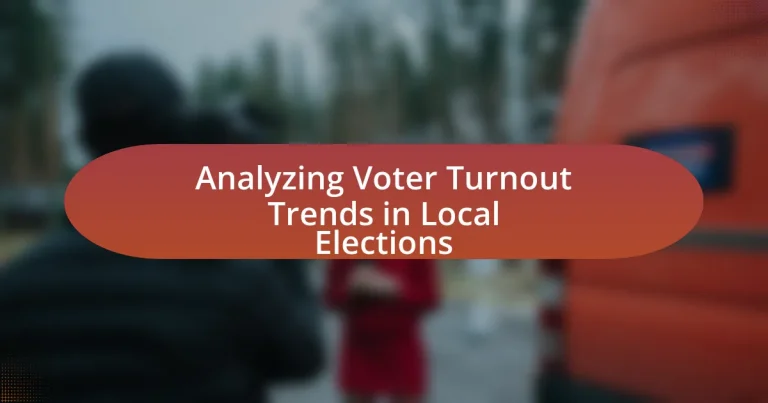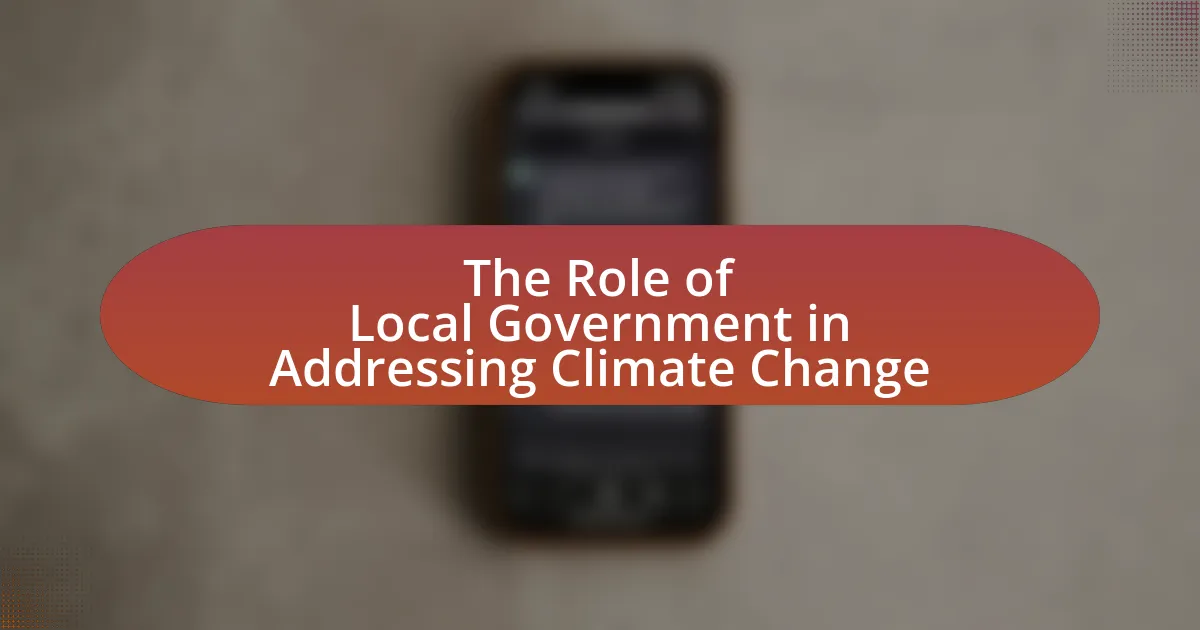The article focuses on analyzing voter turnout trends in local elections, highlighting key factors that influence participation rates. It examines demographic characteristics such as age, education level, and income, noting their significant impact on turnout. The article also discusses the role of election competitiveness and voter engagement initiatives, including outreach programs and early voting options, in enhancing participation. Additionally, it explores external factors like socioeconomic status and local issues that affect voter motivation, as well as methods for measuring turnout trends and the implications of these trends for future elections.
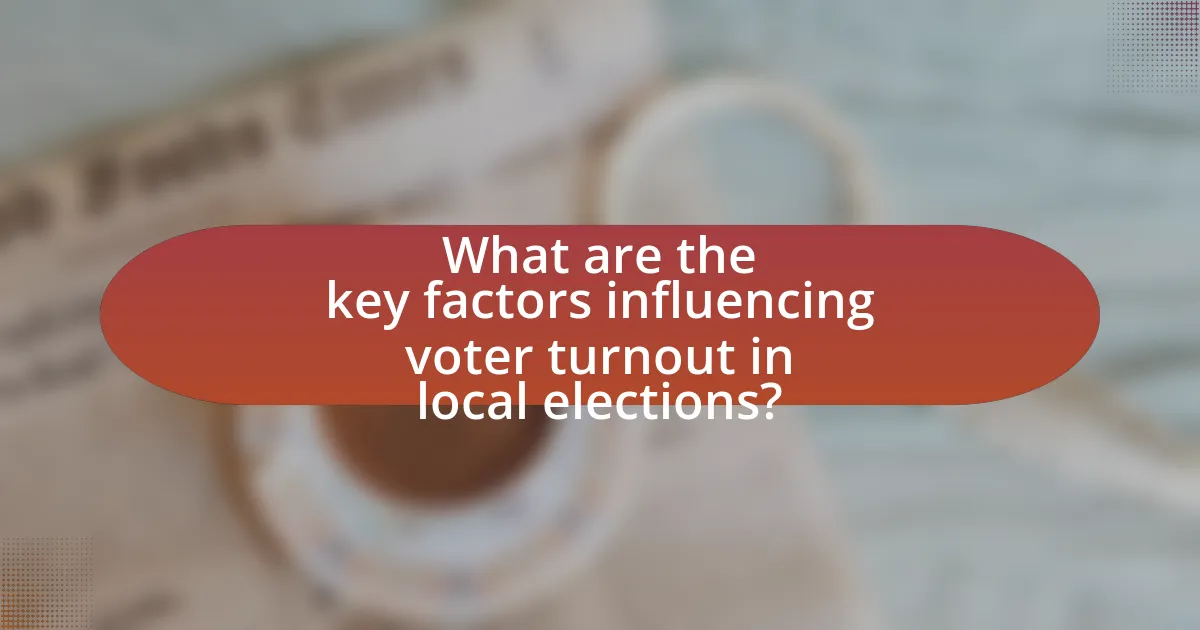
What are the key factors influencing voter turnout in local elections?
Key factors influencing voter turnout in local elections include demographic characteristics, election competitiveness, and voter engagement initiatives. Demographic characteristics such as age, education level, and income significantly affect turnout; for instance, younger voters typically have lower participation rates compared to older voters. Election competitiveness also plays a crucial role; studies show that higher levels of competition between candidates can lead to increased voter interest and turnout. Additionally, voter engagement initiatives, such as outreach programs and early voting options, have been proven to enhance participation rates. Research by the U.S. Census Bureau indicates that local elections with robust community engagement efforts see turnout rates increase by as much as 20%.
How do demographic variables affect voter turnout?
Demographic variables significantly affect voter turnout by influencing participation rates among different groups. For instance, age is a critical factor; younger voters, particularly those aged 18-24, historically show lower turnout rates compared to older age groups, with only about 50% participating in recent elections, while those aged 65 and older often exceed 70%. Additionally, education level plays a vital role; individuals with higher education levels tend to vote at higher rates, with college graduates participating at rates around 80%, compared to those with only a high school diploma, who may vote at rates closer to 50%. Furthermore, racial and ethnic backgrounds also impact turnout; for example, Black and Hispanic voters have shown increased turnout in recent elections, influenced by mobilization efforts and community engagement. These demographic factors collectively shape the landscape of voter participation, as evidenced by data from the U.S. Census Bureau and studies conducted by the Pew Research Center.
What role does age play in local election participation?
Age significantly influences local election participation, with younger voters typically exhibiting lower turnout rates compared to older demographics. Research indicates that individuals aged 18-24 have the lowest participation rates, often below 30%, while those aged 65 and older frequently engage at rates exceeding 70%. This trend can be attributed to factors such as life experience, civic engagement, and the perceived importance of local issues, which tend to resonate more with older voters. Studies, including the U.S. Census Bureau’s Current Population Survey, consistently show that age correlates positively with voter turnout, highlighting the critical role age plays in shaping electoral engagement at the local level.
How does education level impact voter engagement?
Education level significantly impacts voter engagement, with higher educational attainment correlating to increased participation in elections. Studies indicate that individuals with a college degree are more likely to vote compared to those with only a high school diploma. For instance, the U.S. Census Bureau reported that in the 2020 presidential election, approximately 79% of college graduates voted, while only about 53% of those without a high school diploma participated. This trend suggests that education enhances civic knowledge, awareness of political issues, and the perceived importance of voting, thereby driving higher engagement levels among educated individuals.
What external factors influence voter turnout?
External factors that influence voter turnout include socioeconomic status, weather conditions, and the competitiveness of elections. Socioeconomic status affects turnout as individuals with higher income and education levels are more likely to vote; for instance, studies show that in the 2020 U.S. presidential election, 71% of college graduates voted compared to 52% of those without a high school diploma. Weather conditions can also impact turnout; research indicates that inclement weather, such as rain or snow, can decrease voter participation by as much as 10%. Lastly, the competitiveness of an election plays a crucial role; when races are perceived as close, voter turnout tends to increase, as seen in the 2018 midterm elections where highly contested races led to the highest turnout in decades.
How do economic conditions affect local election participation?
Economic conditions significantly influence local election participation by affecting voter motivation and engagement. When economic conditions are poor, such as during recessions, voter turnout tends to decline as individuals may prioritize immediate financial concerns over civic duties. Conversely, during periods of economic growth, increased optimism can lead to higher participation rates, as citizens feel more empowered and invested in their community’s governance. For instance, a study by the Pew Research Center found that economic downturns correlate with a 5-10% decrease in voter turnout in local elections, highlighting the direct impact of economic stability on civic engagement.
What is the impact of local issues on voter turnout?
Local issues significantly impact voter turnout by directly influencing the electorate’s engagement and motivation to participate in elections. When local issues, such as education funding, public safety, or infrastructure development, resonate with voters, they are more likely to feel that their votes can effect change, leading to higher turnout rates. For instance, a study by the Pew Research Center found that local ballot measures related to community concerns can increase voter participation by as much as 20% compared to elections without such measures. This correlation indicates that when voters perceive local issues as relevant to their lives, they are more inclined to engage in the electoral process.
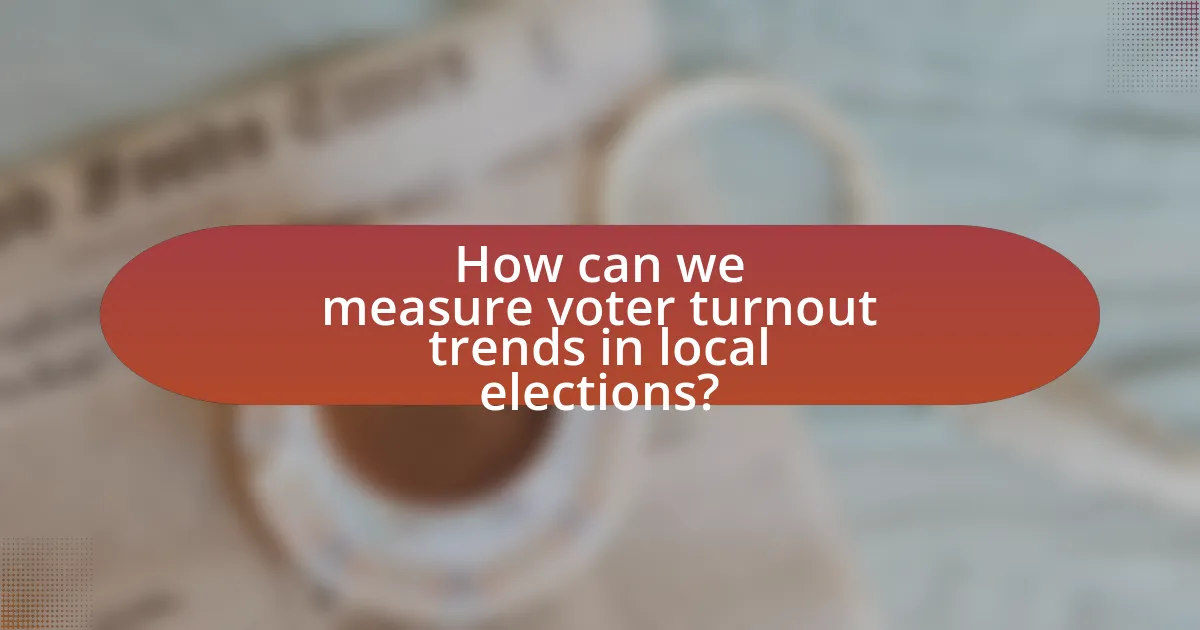
How can we measure voter turnout trends in local elections?
Voter turnout trends in local elections can be measured by analyzing historical voting data, demographic information, and election-specific factors. Historical voting data, such as the percentage of registered voters who cast ballots in previous local elections, provides a baseline for comparison. Additionally, demographic information, including age, race, and socioeconomic status, can reveal patterns in turnout among different groups. Election-specific factors, such as the competitiveness of the race, the presence of ballot measures, and voter engagement efforts, also influence turnout. For instance, a study by the U.S. Census Bureau indicated that local elections typically see lower turnout compared to federal elections, with turnout rates often ranging from 20% to 50% depending on the locality and election type.
What methods are used to collect voter turnout data?
Voter turnout data is primarily collected through methods such as administrative records, surveys, and exit polls. Administrative records involve analyzing official voting data from election authorities, which provides accurate counts of ballots cast. Surveys, conducted by organizations like the U.S. Census Bureau, gather self-reported voting behavior from a sample of the population, offering insights into demographic trends. Exit polls, conducted on election day, capture the voting choices and turnout of individuals as they leave polling places, providing immediate data on voter behavior. These methods collectively ensure a comprehensive understanding of voter turnout trends in local elections.
How do surveys contribute to understanding voter behavior?
Surveys significantly contribute to understanding voter behavior by collecting data on voter preferences, motivations, and demographics. This data allows researchers and political analysts to identify trends and patterns in voting behavior, such as the influence of socioeconomic factors on voter turnout. For instance, a study by the Pew Research Center found that surveys can reveal how issues like healthcare and education impact voter decisions, providing insights into the electorate’s priorities. Additionally, surveys can track changes in public opinion over time, helping to predict electoral outcomes and inform campaign strategies.
What role do official election results play in analysis?
Official election results serve as the primary data source for analyzing voter turnout trends in local elections. These results provide concrete figures on the number of votes cast, voter demographics, and the outcomes of various candidates or measures. By examining these official results, analysts can identify patterns in voter engagement, such as increases or decreases in turnout compared to previous elections, which can be influenced by factors like election competitiveness, voter mobilization efforts, and demographic shifts. For instance, the U.S. Census Bureau reported that voter turnout in the 2020 local elections was significantly higher than in previous years, highlighting the impact of heightened political engagement. Thus, official election results are essential for understanding and interpreting the dynamics of voter participation in local elections.
What statistical tools are effective for analyzing turnout trends?
Statistical tools effective for analyzing turnout trends include regression analysis, time series analysis, and chi-square tests. Regression analysis helps identify relationships between voter turnout and various demographic or socioeconomic factors, allowing for predictions based on historical data. Time series analysis examines turnout data over specific periods, revealing patterns and trends that can inform future elections. Chi-square tests assess the association between categorical variables, such as turnout rates across different demographic groups, providing insights into disparities in voter participation. These tools are widely used in political science research to understand and interpret voter behavior effectively.
How can regression analysis be applied to voter turnout data?
Regression analysis can be applied to voter turnout data by modeling the relationship between various demographic, socioeconomic, and political factors and the likelihood of individuals participating in elections. This statistical method allows researchers to quantify how changes in independent variables, such as income level, education, age, and voter registration laws, influence the dependent variable of voter turnout. For instance, studies have shown that higher education levels correlate with increased voter participation, as evidenced by data from the U.S. Census Bureau, which indicates that individuals with a college degree are significantly more likely to vote compared to those without. By employing regression analysis, analysts can identify key predictors of turnout and assess the impact of specific interventions, such as voter outreach programs, on increasing participation rates in local elections.
What are the limitations of current measurement techniques?
Current measurement techniques for analyzing voter turnout trends in local elections have several limitations, including reliance on self-reported data, which can lead to inaccuracies due to social desirability bias. Additionally, many techniques fail to account for demographic variations, resulting in skewed representations of turnout across different population segments. Furthermore, existing methods often lack real-time data collection capabilities, hindering timely analysis and response to emerging trends. Studies have shown that traditional surveys may underrepresent younger voters and minority groups, further complicating the understanding of turnout dynamics. These limitations highlight the need for more robust and inclusive measurement approaches to accurately capture voter engagement.
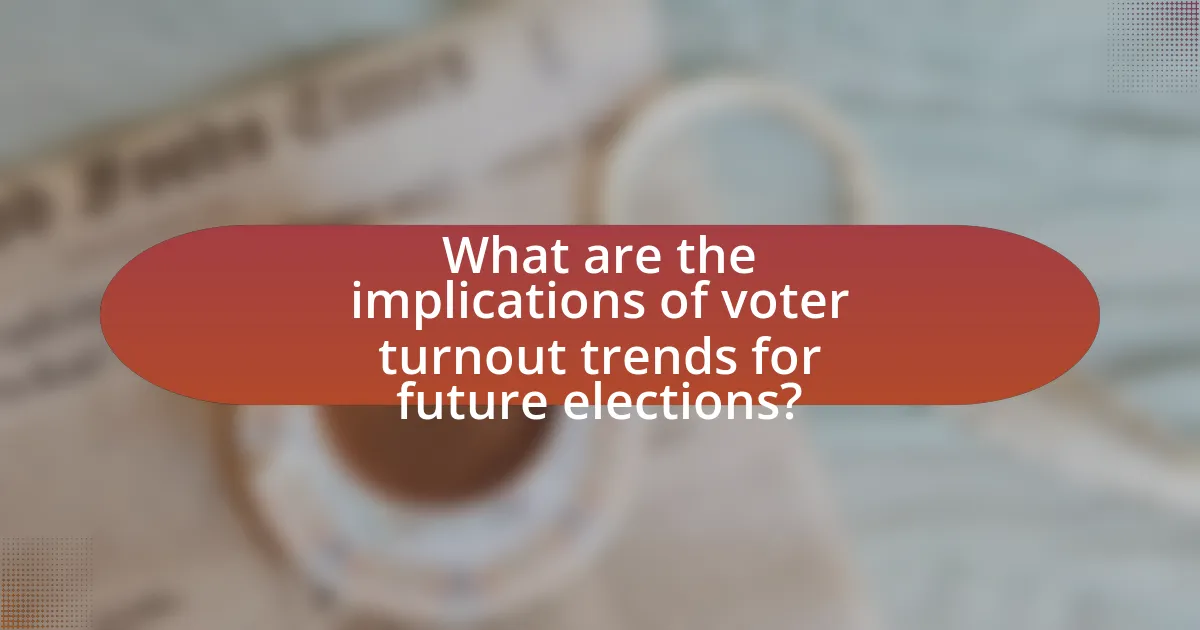
What are the implications of voter turnout trends for future elections?
Voter turnout trends significantly influence future elections by shaping candidate strategies, policy priorities, and electoral outcomes. High turnout often indicates strong civic engagement, prompting candidates to address issues that resonate with a broader electorate, while low turnout may lead to a focus on niche issues that appeal to a smaller, more motivated base. For instance, the 2020 U.S. presidential election saw a turnout of approximately 66.8%, the highest in over a century, which resulted in candidates prioritizing issues like healthcare and racial justice that mobilized diverse voter groups. Conversely, local elections with lower turnout, such as the 2019 municipal elections in various U.S. cities, often reflect a lack of engagement, leading to outcomes that may not represent the broader community’s interests. Thus, understanding these trends is crucial for predicting electoral dynamics and informing campaign strategies.
How do historical trends inform future election strategies?
Historical trends inform future election strategies by providing insights into voter behavior, preferences, and turnout patterns. For instance, analyzing past election data reveals that demographic shifts, such as increasing diversity in urban areas, can influence candidate messaging and outreach efforts. In the 2020 U.S. presidential election, voter turnout among young voters increased significantly compared to previous elections, prompting campaigns to focus more on issues relevant to this demographic, such as climate change and social justice. Additionally, historical voting patterns, such as higher turnout in midterm elections among specific groups, guide strategists in targeting their resources effectively. By leveraging these insights, political campaigns can tailor their strategies to maximize engagement and voter turnout in future elections.
What patterns have emerged from past local elections?
Patterns that have emerged from past local elections include increased voter turnout in areas with competitive races and higher engagement among younger voters. Historical data indicates that local elections with closely contested seats often see turnout rates exceeding 50%, compared to lower rates in non-competitive districts. Additionally, studies show that younger voters, particularly those aged 18-29, have become more active in local elections, with participation rates rising from 20% in 2014 to 35% in 2020, reflecting a growing trend of civic engagement among this demographic.
How can political parties adapt to changing voter demographics?
Political parties can adapt to changing voter demographics by implementing targeted outreach strategies and policy adjustments that resonate with diverse communities. For instance, parties can analyze demographic data to identify emerging voter groups and tailor their messaging to address specific concerns, such as economic opportunities, healthcare access, and social justice. Research from the Pew Research Center indicates that younger voters and voters of color increasingly prioritize issues like climate change and racial equality, suggesting that parties must align their platforms with these values to engage effectively. Additionally, utilizing social media and community engagement initiatives can enhance connection with these demographics, as evidenced by the increased voter turnout among millennials and minority groups in recent elections.
What strategies can increase voter turnout in local elections?
Implementing targeted outreach strategies can significantly increase voter turnout in local elections. These strategies include door-to-door canvassing, which has been shown to boost turnout by 7% to 10%, as evidenced by research from the National Bureau of Economic Research. Additionally, utilizing social media campaigns to engage younger voters can enhance participation, as studies indicate that social media outreach can increase turnout by up to 5%. Providing accessible voting options, such as early voting and mail-in ballots, also contributes to higher turnout rates, with jurisdictions that offer these options experiencing a 20% increase in voter participation compared to those that do not.
How can community engagement initiatives boost participation?
Community engagement initiatives can boost participation by fostering a sense of belonging and ownership among residents. When individuals feel connected to their community and see their input valued, they are more likely to engage in local activities, including voting. Research indicates that communities with active engagement programs experience higher voter turnout; for instance, a study by the Pew Research Center found that neighborhoods with organized outreach efforts saw a 15% increase in participation during local elections. This correlation highlights the effectiveness of initiatives that promote dialogue, education, and collaboration, ultimately leading to increased civic involvement.
What role does technology play in enhancing voter turnout?
Technology significantly enhances voter turnout by facilitating easier access to voting information and streamlining the voting process. For instance, online voter registration has increased participation rates, as evidenced by a study from the Pew Research Center, which found that states with online registration saw a 10% increase in voter turnout compared to those without. Additionally, mobile applications and social media platforms provide voters with timely reminders and information about upcoming elections, further encouraging participation. The use of electronic voting machines also reduces wait times at polling places, making it more convenient for individuals to cast their votes.
What best practices can be implemented to improve voter turnout?
To improve voter turnout, implementing targeted outreach strategies is essential. Research indicates that personalized communication, such as door-to-door canvassing and phone banking, significantly increases voter engagement. For instance, a study by the National Bureau of Economic Research found that door-to-door canvassing can increase turnout by 7% to 10%. Additionally, simplifying the voting process through measures like automatic voter registration and extended voting hours has proven effective; states that adopted automatic registration saw an increase in voter participation by approximately 5%. Furthermore, leveraging social media platforms for voter education and mobilization can reach younger demographics, who are typically less engaged. These practices collectively enhance voter turnout by addressing barriers and fostering a more informed electorate.
